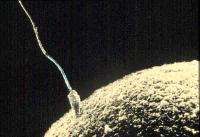Sperm can count

The speed at which the calcium concentration in the cell changes controls the swimming behavior of sperm. They can calculate the calcium dynamics and react accordingly.
Sperm have only one aim: to find the egg. The egg supports the sperm in their quest by emitting attractants. Calcium ions determine the beating pattern of the sperm tail which enables the sperm to move. Together with colleagues from the Max Planck Institute for the Physics of Complex Systems in Dresden and the University of Göttingen, scientists from the caesar research centre in Bonn, an institute of the Max Planck Society, have discovered that sperm only react to changes in calcium concentration but not to the calcium concentration itself. Probably sperm make this calculation so that they remain capable of manoeuvring even in the presence of high calcium concentrations.
The swimming path on which sperm follow the mating call of the egg, varies according to species. Sperm – in particular those of marine species – swim along convoluted paths in a chemical concentration gradient. Their swimming style is controlled by the calcium ions in the sperm tail. It was previously believed that in high calcium concentrations, the sperm tails make asymmetrical, whip-like movements and their swimming path is very curved, while in low calcium concentrations, the tails beat symmetrically and the sperm swim on a straight line. The alternation of high and low calcium concentrations was thought to propel sperm along spiral-shaped swimming paths. However, this simple model was repudiated by experiments on freely-swimming sperm and presented researchers with something of a mystery.
The scientists have now succeeded in solving this mystery. Using ingenious stroboscopic laser illumination – similar to that used in discotheques – project leader Luis Alvarez was able to trace the movement of a sperm in detail, and simultaneously measure the changes in the calcium concentration. The result was astonishing: the sperm tail only reacted to the time derivative of the calcium concentration and the absolute concentration was of little relevance. To put it simply: sperm can count! Exactly how they do this is unclear. The caesar scientists suspect that sperm bind calcium ions with the help of two proteins and in thereby create a "chemical derivative", so to speak.
But why do sperm carry out this complicated kind of calculation that we first encounter at upper secondary school level? The concentration of the attractants and, therefore also, the calcium concentration in the sperm is very high near the egg. The mathematical trick probably enables the sperm to be able to react even in the presence of such high calcium concentrations.
Apart from calcium, many other messenger substances control cell functions. Is it possible, therefore, that cells also carry out complex chemical calculations involving other messenger substances? The Bonn scientists would like to investigate this important question next.
More information: Alvarez, L., Dai, L., Friedrich, B. M., Kashikar, N., Gregor, I., Pascal, R. & Kaupp, U. B. (2012) "The rate of change in Ca2+ concentration controls sperm chemotaxis" J. Cell. Biol. Online publication: 27 February 2012. doi: 10.1083/jcb.201106096
Provided by Max-Planck-Gesellschaft
















